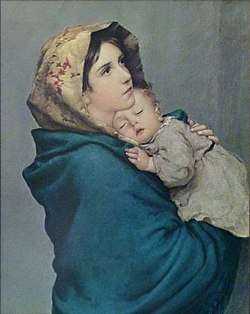Roberto Ferruzzi
Roberto Ferruzzi (Italian: [roˈbɛrto ferˈruʦʦi]; 16 December 1853 – 16 February 1934)[1] was an Italian artist. He is best known for the painting Madonnina[2] that won the second Venice Biennale in 1897.
Roberto Ferruzzi | |
|---|---|
 A copy of the Madonnina | |
| Born | Roberto Ferruzzi 16 December 1853 Šibenik, Dalmatia |
| Died | 16 February 1934 (aged 80) Venice, Italy |
| Nationality | Italian |
Notable work | Madonnina |
Biography
Roberto Ferruzzi was born in Šibenik, Dalmatia in 1853 to Italian parents. At the age of four he moved to Venice with his family. After the death of his father, a lawyer, he returned to Dalmatia to study classics. In 1868, he returned to Venice to enroll in the Liceo Marco Foscarini. He subsequently entered the University of Padua, and graduated with a law degree, however instead of practicing law he gained vocation as a self-taught painter.[3]
Afterwards, he moved to Luvigliano, a frazione of Torreglia, where he painted Madonnina in 1897.[4]
Ferruzzi exhibited his work for the first time in 1883 in Turin, consisting mostly of figure paintings. In 1887, he exhibited a canvas in Venice titled La prima penitenza, a genre painting of a boy praying a rosary in penance for bad behavior, whilst his grandmother looks on amused. In 1891-1892 at the Palermo exposition his genre painting Hush! won an award. In 1897, he exhibited the Madonnina and Toward the Light in Venice.[5]
Ferruzzi died on 16 February 1934 in Venice and was buried in the small cemetery of Luvigliano in his family's plot, near his wife Ester Sorgato and his daughter Mariska.
He bore two descendants of the same name: his son Roberto (nicknamed Bobo), a painter of lagoons; and his grandson Roberto (nicknamed Robi), an art appraiser and antiquarian.
References
- IL DALMATA, ottobre 2008, PDF
- Madonna of the Streets
- La Biennale di Venezia, Volume 2, by Esposizione (2 : 1897) page 109-110.
- "Madonnina del Ferruzzi" (in Italian). luvigliano.it. Retrieved 17 December 2014.
- History of Modern Italian Art, by Ashton Rollins Willard (1902), page 644-645.